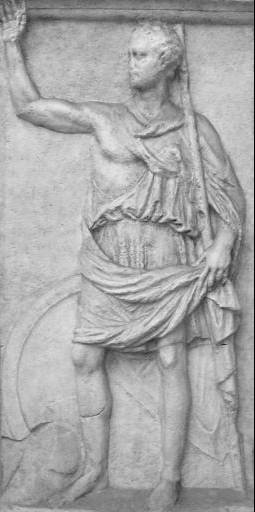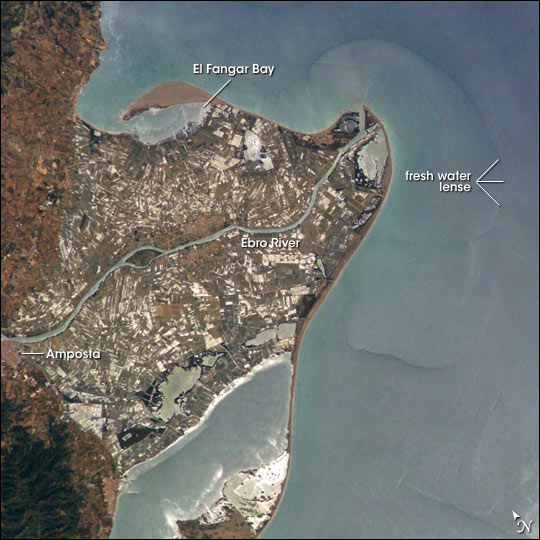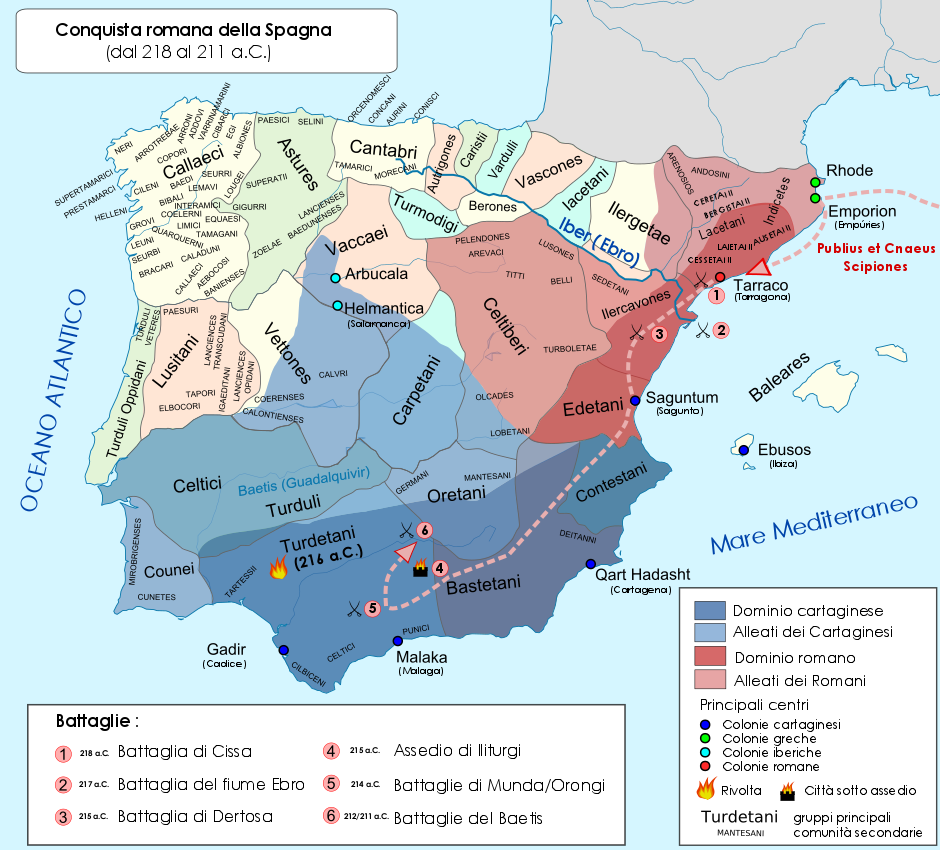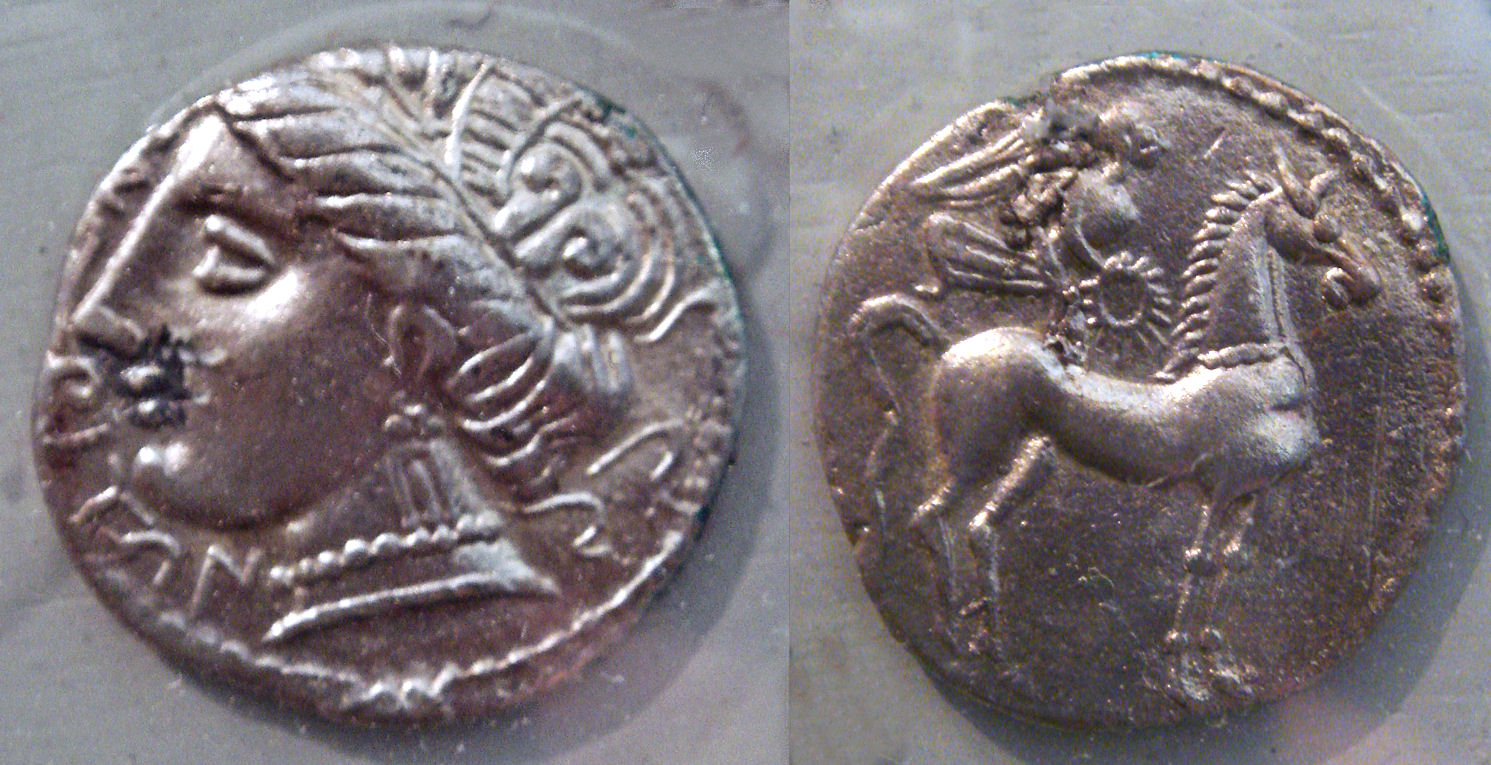|
Gnaeus Cornelius Scipio Calvus
Gnaeus Cornelius Scipio Calvus (died 211 BC) was a Roman general and statesman during the third century BC. He played a major part in the Second Punic War, establishing Roman rule in the east of the Iberian peninsula and tying up several Carthaginian armies to keep them from reinforcing Hannibal. Family Gnaeus Cornelius Scipio Calvus was a member of the patrician family of the Cornelii Scipiones. His father was Lucius Cornelius Scipio, consul of 259 BC, the son of the patrician censor of 280, Lucius Cornelius Scipio Barbatus. His younger brother was Publius Cornelius Scipio, consul of 218 and father of the famous Scipio Africanus (the most famous of the Scipios). Gnaeus Cornelius Scipio was nicknamed Calvus (the bald) to distinguish him from his uncle, another Gnaeus Cornelius Scipio, who was nicknamed Asina (donkey) and who had been consul twice during the First Punic War. Consulship Gnaeus Cornelius was elected consul for 222 BC with Marcus Claudius Marcellus as his co-co ... [...More Info...] [...Related Items...] OR: [Wikipedia] [Google] [Baidu] |
Second Punic War
The Second Punic War (218 to 201 BC) was the second of Punic Wars, three wars fought between Ancient Carthage, Carthage and Roman Republic, Rome, the two main powers of the western Mediterranean Basin, Mediterranean in the 3rd century BC. For 17 years the two states struggled for supremacy, primarily in Roman Italy, Italy and Iberia, but also on the islands of Sicily and Sardinia and, towards the end of the war, in North Africa. After immense materiel and human losses on both sides, the Carthaginians were once again defeated. Macedonia (ancient kingdom), Macedonia, Kingdom of Syracuse, Syracuse and several Numidians, Numidian kingdoms were drawn into the fighting, and Celtiberians, Iberian and Gauls, Gallic forces fought on both sides. There were three main Theater (military), military theatres during the war: Italy, where Hannibal defeated the Roman legions repeatedly, with occasional subsidiary campaigns in Sicily, Sardinia and Greece; Iberia, where Hasdrubal (Barcid), Hasdru ... [...More Info...] [...Related Items...] OR: [Wikipedia] [Google] [Baidu] |
Massilia
Massalia (; ) was an ancient Greek colony (''apoikia'') on the Mediterranean coast, east of the Rhône. Settled by the Ionians from Phocaea in 600 BC, this ''apoikia'' grew up rapidly, and its population set up many outposts for trading in modern-day Spain, Corsica and Liguria. Massalia persisted as an independent colony until the Roman campaign in Gaul in the 1st Century BC. The ruins of Massalia still exist in the contemporary city of Marseille, which is considered the oldest city of France and one of Europe's oldest continuously inhabited settlements. History Massalia was established ca. 600 BC by Ionian Greek settlers from Phocaea, in Western Anatolia. After the capture of Phocaea by the Persians in 545 BC, a new wave of settlers fled towards the colony. A creation myth telling the meeting between the Greeks and the local population is given by Aristotle and Pompeius Trogus (see founding myth of Marseille). After the middle of the 6th century BC, Massalia became an impo ... [...More Info...] [...Related Items...] OR: [Wikipedia] [Google] [Baidu] |
Tortosa
Tortosa (, ) is the capital of the '' comarca'' of Baix Ebre, in Catalonia, Spain. Tortosa is located at above sea level, by the Ebro river, protected on its northern side by the mountains of the Cardó Massif, of which Buinaca, one of the highest peaks, is located within Tortosa's municipal boundary. Before Tortosa, across the river, rise the massive Ports de Tortosa-Beseit mountains. The area around Mont Caro and other high summits are often covered with snow in the winter. Population centres * Bítem, 1.139; includes Santa Rosa * Campredó, 1.168; * Jesús, 3.755 * Els Reguers, 679 *Tortosa, 27.131 * Vinallop, 363, includes Mianes The municipality includes a small exclave to the west. History Tortosa (from or , via ''Ṭurṭūshah'') is probably identical to the ancient Hibera, capital of Ilercavonia. This may be the ancient settlement the remains of which have been found on the hill named Castillo de la Zuda. In Roman times, the town took the name Dertosa (). To ... [...More Info...] [...Related Items...] OR: [Wikipedia] [Google] [Baidu] |
Ebro River
The Ebro (Spanish and Basque ; , , ) is a river of the north and northeast of the Iberian Peninsula, in Spain. It rises in Cantabria and flows , almost entirely in an east-southeast direction. It flows into the Mediterranean Sea, forming a delta in the Terres de l'Ebre region, in southern Catalonia. In the Iberian peninsula, it ranks second in length after the Tagus and second in discharge volume, and drainage basin, after the Douro. It is the longest river entirely within Spain; the other two mentioned flow into Portugal. The Ebro flows through many cities (): Reinosa in Cantabria; Frías and Miranda de Ebro in Castile and León; Haro, Logroño, Calahorra, and Alfaro in La Rioja; Tudela in Navarre; Alagón, Utebo, and Zaragoza in Aragon; and Flix, Móra d'Ebre, Benifallet, Tivenys, Xerta, Aldover, Tortosa, and Amposta in the province of Tarragona (Catalonia). Geography Upper part and tributaries The source of the river Ebro is in the Cantabrian Mountains, in ... [...More Info...] [...Related Items...] OR: [Wikipedia] [Google] [Baidu] |
Quinqueremes
From the 4th century BC on, new types of oared warships appeared in the Mediterranean Sea, superseding the trireme and transforming naval warfare. Ships became increasingly large and heavy, including some of the largest wooden ships hitherto constructed. These developments were spearheaded in the Hellenistic Near East, but also to a large extent shared by the naval powers of the Western Mediterranean, specifically Carthage and the Roman Republic. While the wealthy successor kingdoms in the East built huge warships ("polyremes"), Carthage and Rome, in the intense naval antagonism during the Punic Wars, relied mostly on medium-sized vessels. At the same time, smaller naval powers employed an array of small and fast craft, which were also used by the ubiquitous pirates. Following the establishment of complete Roman hegemony in the Mediterranean after the Battle of Actium, the nascent Roman Empire faced no major naval threats. In the 1st century AD, the larger warships were retained ... [...More Info...] [...Related Items...] OR: [Wikipedia] [Google] [Baidu] |
Indibilis And Mandonius
Indibilis and Mandonius (fl. 3rd century BC) were chieftains of the Ilergetes, an ancient Iberian people based in the Iberian Peninsula. Polybius speaks of the brothers as the most influential and powerful of the Iberian chieftains in that period.Smith, p. 572 Livy calls one of the chieftains of the Ilergetes "Indibilis".Livy 22.21 at the same time, Polybius gives "Andobales" for the same person. They agree that his brother chieftain was Mandonius.Polybius 3.76 Biography Indibilis fought against the Romans and sided with the Carthaginians at the Battle of Cissa in 218 BC, when Gnaeus Cornelius Scipio Calvus fought them. Indibilis and Carthaginian general Hanno were defeated at this battle and became a prisoner. In 217 BC, Indibilis regained his freedom and, with his younger brother Mandonius, decided to harass neighbouring Iberian tribes who were friendly to, or in alliance with, Rome. This harassment was fended off by Scipio Calvus by counter measures that involved ki ... [...More Info...] [...Related Items...] OR: [Wikipedia] [Google] [Baidu] |
Hasdrubal Barca
Hasdrubal Barca (245– 22June 207BC), a latinization of names, latinization of ʿAzrubaʿal () son of Hamilcar Barca, was a Ancient Carthage, Carthaginian general in the Second Punic War. He was the brother of Hannibal and Mago Barca. Youth and Iberian leadership Little is known of Hasdrubal's early life. He was present, along with his older brother Hannibal, when his father, Hamilcar Barca, died in battle against the Iberians. Hamilcar may have drowned in the Júcar, although the sources do not agree. Little is also known about Hasdrubal's activities during the time Hasdrubal the Fair led the Punic forces in Spain, or during the campaigns of Hannibal Barca in Spain and his Siege of Saguntum. Hannibal left a force of 13,000 infantry, 2,550 cavalry and 21 war elephants in Hispania when he marched for Italy in 218 BC. Hasdrubal commanded this force and he was to set out for Italy in 217 BC to reinforce Hannibal. Hannibal left another army under Hanno in Catalonia, consisting of ... [...More Info...] [...Related Items...] OR: [Wikipedia] [Google] [Baidu] |
Empúries
Empúries ( ) was an ancient Greek city on the Mediterranean coast of Catalonia, Spain. The city Ἐμπόριον (, Emporion, meaning "trading place", ''cf.'' emporion) was founded in 575 BC by Greeks from Phocaea. After the invasion of Gaul from Iberia by Hannibal the Carthaginian general in 218 BC, the city was occupied by the Romans (Latin: ). In the Early Middle Ages, the city's exposed coastal position left it open to marauders and it was abandoned. Empúries is located within the Catalan comarca of Alt Empordà on the Costa Brava. The ruins are midway between the town of L'Escala and the tiny village of Sant Martí d'Empúries. History Empúries was founded on a small island at the mouth of the river Fluvià, in a region inhabited by the Indigetes (at the present time, the mouth of the Fluvià is about 6 km to the north). This city came to be known as the ''Palaiapolis'', the "old city" when, towards 550 BC, the inhabitants moved to t ... [...More Info...] [...Related Items...] OR: [Wikipedia] [Google] [Baidu] |
Ala (Roman Allied Military Unit)
An ''ala'' (Latin for "wing"; ''alae'') was the term used during the middle of the Roman Republic (338–88 BC) to denote a military formation composed of conscripts from the ''socii'', Rome's Italian military allies. A normal consular army during the period consisted of two legions, composed of only Roman citizens, and two allied ''alae''. The ''alae'' were somewhat larger than normal legions, 5,400 or 5,100 men against the legion's 4,500 men, and it contained a greater quantity of cavalry, usually 900 horsemen against the 300 supplied by the Romans. From the time of the first Roman emperor, Augustus (ruled 27 BC – AD 14), the term ''ala'' was used in the professional imperial army to denote a much smaller (), purely cavalry unit of the non-citizen ''auxilia'' corps: see ala (Roman cavalry unit). History When the Roman armies started being composed partly of Roman citizens and partly of ''socii'' (allies from the rest of the Italian mainland), either Latini or Italici, it ... [...More Info...] [...Related Items...] OR: [Wikipedia] [Google] [Baidu] |
Roman Legion
The Roman legion (, ) was the largest military List of military legions, unit of the Roman army, composed of Roman citizenship, Roman citizens serving as legionary, legionaries. During the Roman Republic the manipular legion comprised 4,200 infantry and 300 cavalry. After the Marian reforms in 107 BC, the legions were formed of 5,200 men and were restructured around 10 cohorts, the first cohort being double strength. This structure persisted throughout the Principate and Roman Empire, middle Empire, before further changes in the fourth century resulted in new formations of around 1,000 men. Size The size of a typical legion varied throughout the history of ancient Rome, with complements ranging from 4,200 legionaries and 300 ''equites'' (drawn from the wealthier classes – in early Rome all troops provided their own equipment) in the Republic, to 5,500 in the Imperial period, when most legions were led by a Roman Imperial Legate. A legion had 4,800 Legionary, legionaries ( ... [...More Info...] [...Related Items...] OR: [Wikipedia] [Google] [Baidu] |
Northern Italy
Northern Italy (, , ) is a geographical and cultural region in the northern part of Italy. The Italian National Institute of Statistics defines the region as encompassing the four Northwest Italy, northwestern Regions of Italy, regions of Piedmont, Aosta Valley, Liguria and Lombardy in addition to the four Northeast Italy, northeastern Regions of Italy, regions of Trentino-Alto Adige/Südtirol, Trentino-Alto Adige, Veneto, Friuli-Venezia Giulia and Emilia-Romagna. With a total area of , and a population of 27.4 million as of 2022, the region covers roughly 40% of the Italian Republic and contains 46% of its population. Two of Italy's largest metropolitan areas, Milan and Turin, are located in the region. Northern Italy's GDP was estimated at Euro, €1 trillion in 2021, accounting for 56.5% of the Italian economy. Northern Italy has a rich and distinct culture. Thirty-seven of the fifty-nine List of World Heritage Sites in Italy, World Heritage Sites in Italy are found in the re ... [...More Info...] [...Related Items...] OR: [Wikipedia] [Google] [Baidu] |
Alps
The Alps () are some of the highest and most extensive mountain ranges in Europe, stretching approximately across eight Alpine countries (from west to east): Monaco, France, Switzerland, Italy, Liechtenstein, Germany, Austria and Slovenia. The Alpine arch extends from Nice on the western Mediterranean Sea, Mediterranean to Trieste on the Adriatic Sea, Adriatic and Vienna at the beginning of the Pannonian Basin. The mountains were formed over tens of millions of years as the African and Eurasian tectonic plates collided. Extreme shortening caused by the event resulted in marine sedimentary rocks rising by thrust fault, thrusting and Fold (geology), folding into high mountain peaks such as Mont Blanc and the Matterhorn. Mont Blanc spans the French–Italian border, and at is the highest mountain in the Alps. The Alpine region area contains 82 peaks higher than List of Alpine four-thousanders, . The altitude and size of the range affect the climate in Europe; in the mountain ... [...More Info...] [...Related Items...] OR: [Wikipedia] [Google] [Baidu] |







